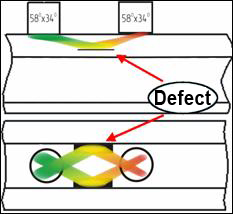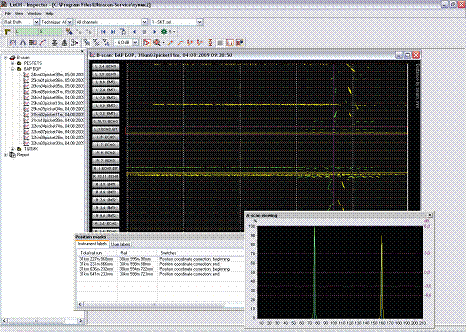

Flaw detector advantages
- Rail complete sounding (excluding the foot flanges), due to the flaw detector multi-channeling;
- built-in standard setups for channels operation;
- defining the traveled distance and motion speed during the complete testing;
- real-time display of testing results in B-Scan mode (by 4 channels);
- sounding and storing the information in every millimeter of traveled distance via all channels is provided in the flaw detector;
- recoding the testing results at different sensitivity levels;
- registration of all testing results and advanced capabilities of data analysis;
- application of the flaw detector with the base sounding scheme allows to detect all types of fatal defects, appearing while rail track maintenance.
Flaw detector distinctive features
- Large high brightness color TFT display;
- synchronization by encoder;
- results display: А-scan, B-scan;
- number of channels for complete testing: 26;
- number of channels for manual testing: 2;
- techniques and schemes for rail head testing:
- pulse echo technique by angle-beam probe for testing of gauge and field face sides of along and against the movement;
- pulse echo technique by angle-beam probe for testing of the rail head centre along and against the movement;
- echo-mirror technique by angle-beam probe for testing of the rail head centre along and against the movement;
- echo-mirror technique by angle-beam probe for testing of gauge and field sides along and against the movement.


Fig. Pulse echo techniques for rail head testing


Fig. echo-mirror techniques for rail head testing
- Techniques and schemes for the web testing and its projection in the foot:
- pulse echo and echo-images techniques for detection of longitudinal horizontal cracks with straight-beam double creastal probe;
- pulse echo technique for detection of transverse cracks and testing of weld joints with angle-beam probe.


Fig. Pulse echo techniques for the rail web and foot testing
Flaw detector using the base sounding scheme enables to detect all types of fatal defects with the following features:


Fig. - Types of sharp-defective rails
- transverse cracks in the 2nd-category rail head, including well-developed transverse cracks with reflecting surface and including the ones developed under horizontal roll surface separations which are not detected by standard pulse echo technique;
- longitudinal horizontal cracks in the web, even if they did not reach the rail axis in their development, and also in the head, including the ones that do not go beyond the web projection;
- longitudinal horizontal cracks located in the middle of the rail height;
- cracks from bolt holes, including the ones in early stage of their development when they do not go beyond the bolt hole projection to the roll surface;
- vertical cracks in the foot and web located mainly along the rail axis;
- transverse corrosion cracks in the foot located in the web projection area.
Instrument service functions

- Sound and visual alarm, modes switching with the help of “hot buttons”;
- possibility of electronic registration of testing results by all channels allow to perform their reinterpretation and make complete reports;
- mode of defyning the rail type and automatic correction of setups;
- mode of bolt holes testing by special setups;
- for in-depth analysis of detected signals, except for the usual information display in the form of А-scan, the B-type sweep is used in real time by one, two, four channels (left and right rail of driving into and driving out channels) is applied;
- possibility of TCG curve (of any shape) plotting.

Fig. Modes of testing results display in A-scan and B-scan on the flaw detector screen
Additional software
"Rail Inspector 1.6" is intended for viewing and analysis of testing results obtained by the UDS2-73 double rail ultrasonic flaw detector and serves for interpretation carrying out and display of information on suspicious rail sections. The present program provides operation with the data stored on a personal computer.
Main advantages of program application are:

- Convenient operation with the tested sections (spans) database;
- possibility to select various grouping of testing channels, testing rail, rail testing area, testing technique;
- possibility to measure the conditional dimensions in B-scan mode;
- possibility to view А-scan by the stored data in B-scan mode;
- possibility to move throughout the defectogram (B-scan) by means of scrolling mode or mode of fast shift to the set coordinate;
- “Position marks” mode for suspicious rail sections marking during testing results review;
- mode of testing results filtering by the sensitivity level from minus 6 to plus 6 dB relative to ALARM level;
- mode of viewing and generation of reports on the selected testing section.
Main specifications:
| Overall dimensions of flaw detector without a handle and with one ultrasonic unit and power unit | no more than (1040×1640×1130) mm; in transport position – no more than (900×2060×600) mm.
|
|
| Equipped flaw detector weight | no more than 75 kg. | |
| Keypad | English, Russian. | |
| Languages | English, Russian. | |
| Number of multiplexer units (MUX) | 4 | |
| Number of ultrasonic channels | 28 channels. | |
| Connectors | BNC, RS-19. | |
| Data storage | Flash-card. | |
| Independent power source | NiMH storage battery with rated voltage of 12 V and rated capacity 17 А∙h. |
|
| Operation time | 8 hours. | |
| Flaw detector consumed electric power | no more than 30 V•А. | |
| Time of flaw detector operation mode setup | no more than 15 sec. | |
| Display type | 800×480 pixels. | |
| Screen dimensions (width, height, diagonal) | 155 mm, 95 mm, 180 mm (7.5 inches). | |
| Warranty | 1 year. | |
| INTERFACES |
||
| USB | USB-A (host), USB-B (slave). | |
| Trigger O | available. | |
| Headphones | available. | |
| Encoder output | 1-axis encoder line. | |
| MAIN METROLOGICAL PERFORMANCES |
||
| The limits of admissible main absolute error of flaw detector during the measurement of depth dН and coordinates |
|
|
| The limits of admissible main absolute error during the measurement of signals amplitudes ratio ∆N at the reception path input in the gain range from 20 dB to 80 dB |
∆N = ±(0.2+0.03N); ∆N ─ main absolute error during signals amplitudes ratio measurement, dB; |
|
| Time instability of flaw detector reception path sensitivity | ± 0.5 dB for 8 hours of continuous operation. | |
| Protection level in operation | IP 64 | |
| Ambient temperature | from minus 400 to plus 500С. | |
| Atmospheric pressure | from 84 to 106,7 kPa. | |
| Relative humidity | (93 ± 3) at a temperature 25 ºС. | |
| Flaw detector in shipping package is resistant to the influence of |
|
|
| Flaw detector retains its parameters when it is influenced by electromagnetic interferences which do not exceed the following norms |
|
|
| Full average flaw detector lifetime | no less than 10 years. | |
| Probability of no-failure operation | no less than 0.9 for 2 000 h. | |
| PULSER |
||
| Initial pulse type | Short pulse of negative polarity. | |
| Initial pulse frequency | One-channel mode – 250 Hz; complete mode – no more than 1000 Hz. | |
| Amplitude | 180 V | |
| Duration | 60±10 ns | |
| Rising edge duration | no more than 20 ns. | |
| Triggering | from an initial pulse, from an encoder. | |
| RECEIVER |
||
| Gain | from 0 to 100 dB with a step of 0.1, 1, 10 dB. | |
| Input signal | no more than 2 V from a peak to a peak. | |
| Input reception path resistance | no more than 300 Ω. | |
| Digital filter | 1 standard digital filter with central frequency 2.5 MHz. | |
| Rectifier | envelope. | |
| SETUPS MODE |
||
| Measurements | mm | |
| Testing range | from 0 to 1000 mm, with a step 1, 10, 100 mm. | |
| Velocity | from 2000 m/s to 8000 m/s, with a step 1, 10, 100, 1000 m/s. | |
| Probe zero | from 0 to 60 µs, with a step 0.1, 1 µs. | |
| Range delay | from 0 to 1000 µs, with a step 1, 10, 100 µs. | |
| Probe angle | from 0 to 900, with a step 100, 1000 |
|
| CYCLES/GATES |
||
| Number of cycles | max. number of cycles 16. | |
| Cycle duration | 0.01 - 0.4 ms. | |
| Number of gates in a cycle | max. number of gates 2 for each channel. | |
| Gate fixation level | from 0 % to 100 % of vertical screen scale. | |
| ALARM | When the signal goes beyond the ALARM level, when the signal stays within the ALARM level. | |
| ALARM system | ||
| Sound ALARM system | sound – separate for each rail and combined (for a group of channels); range of pulse frequency setup of alarm system sound indicator is from 0.5 to 5 kHz, with a step 100 Hz. |
|
| Light ALARM | light – separate for each rail and combined (via all ensounding channels); visual by the screen – separate for each rail and each channel. |
|
| MEASUREMENTS IN A-SCAN MODE |
||
| Displayed parameters | 4 measuring parameters are displayed in a status bar. | |
|
||
TCG curve |
max. number of dots in a gate - 14 per cycle, dynamic range - 100 dB, vertically adjustable step - 1 dB, horizontally adjustable step – 2 dB. |
|
| MEASUREMENTS IN B-SCAN MODE | ||
| “Raw” B-Scan |
|
|
Delivery set of double rail ultrasonic rail flaw detector UDS2-73 (v.3.0)
Far-abroad countries Appendix B. List of spare parts (Far-abroad)














